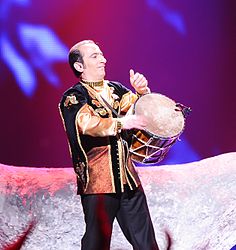Qoltuq nagara
 |
|
| Other names | Koltuk davulu |
|---|---|
| Classification | Percussion instrument (membranophone) |
The Qoltuq nagara(Armpit drum) (Armenian: Դհոլ, Georgian: დოლი, Azerbaijani: Qoltuq nağara) is a folk drum with double head that is played on one side with the bare hands. It is used in Armenia, Turkey, Iranian Azerbaijanis, AzerbaijanGeorgia and other Caucasus regions. It has different names, according to the territory in which it is played. This membranophone is different from the dhol and nagara of India.
The dhol is a common folk instrument played in Armenia, as well as historically throughout Armenian history, since the times of Cilicia, the Armenian Kingdom. The dhol may be played with sticks, mallets, or with the palms of the hands and the fingers. Once used during military campaigns, the dhol is now played in folkloric trios (the duduk and zurna complementing the dhol) and orchestra.
The Armenian Highlands have been home to Armenians for thousands of years, so it is believed that either the Armenian merchants from Silk Road brought the instrument from India, or vis-versa.
The nağara (also called koltuk davulu) is a Turkish folk drum or percussion instrument. It is placed under the arm and beaten with the hands. It is longer compared to the regular drums and its diameter is smaller.
The doli is played across Georgia in the Caucasus. The body consists of a hollow wooden cylinder covered with leather tightly attached to it with iron rings. It is played by palms and fingers, under or over the arm, while sitting or dancing. It is struck in the center to get the forte effect and at the edges to get a piano effect. The doli’s height and diameter of the body and head is about 3 to 1. It is mostly men who play the doli. In performance, the doli creates the rhythm of the dance. The doli is often combined with other regional instruments including the chonguri, the chiboni, the salamuri, the buzika and the duduki.
...
Wikipedia
